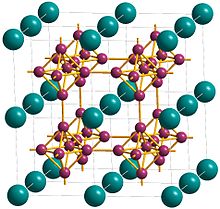Strontium hexaboride

| |
| Names | |
|---|---|
| Other names
strontium hexaboride
| |
| Identifiers | |
3D model (JSmol)
|
|
| ECHA InfoCard | 100.031.778 |
| EC Number |
|
PubChem CID
|
|
CompTox Dashboard (EPA)
|
|
| |
| |
| Properties | |
| SrB6 | |
| Molar mass | 152.49 g/mol |
| Appearance | black crystalline powder |
| Density | 3.39 g/cm3, solid (15.0°C) |
| Melting point | 2,235 °C (4,055 °F; 2,508 K) |
| insoluble | |
| Structure | |
| Cubic | |
| Pm3m ; Oh | |
| Hazards | |
| NFPA 704 (fire diamond) | |
Except where otherwise noted, data are given for materials in their standard state (at 25 °C [77 °F], 100 kPa).
| |
Strontium boride (SrB6) is an inorganic compound. At room temperature, it appears as a crystalline black powder.[1] Closer examination reveals slightly translucent dark red crystals capable of scratching quartz.[2] It is very stable and has a high melting point and density. Although not thought to be toxic, it is an irritant to the skin, eyes, and respiratory tract.[1]
Magnetism[edit]
Strontium boride, along with other alkali-earth metal borides, has been shown to exhibit weak ferromagnetism at low temperatures.[3] This is thought by some to be caused by slight impurities or aberrations in the crystal lattice,[4][5] while others suggest different explanations are needed.[6] Strontium boride has also been examined for semiconducting properties at lower temperatures.[7]
Preparation[edit]
In his book The Electric Furnace, Henri Moissan describes an early synthesis of strontium boride by mixing strontium borate, aluminum, and carbon in an electric furnace.[2] Alternatively, a solid-phase synthesis of strontium boride can be carried out by reacting two moles of strontium carbonate with three moles of boron carbide and one mole of carbon inside a vacuum furnace.[8]
Uses[edit]
Strontium boride is used in insulation and nuclear control rods.[8] A recent patent filed for aircraft windows uses SrB6 nanoparticles in a transparent acrylic sheet. The IR-absorbing properties of these nanoparticles prevents the transmittance of infrared wavelengths while still allowing the transmittance of visible light.[9]
References[edit]
- ^ a b "Archived copy" (PDF). Archived from the original (PDF) on 2006-02-09. Retrieved 2009-05-01.
{{cite web}}: CS1 maint: archived copy as title (link) - ^ a b Moissan, Henri. The Electric Furnace.
- ^ Young, D. P.; Hall, D.; Torelli, M. E.; Fisk, Z.; Sarrao, J. L.; Thompson, J. D.; Ott, H. R.; Oseroff, S. B.; Goodrich, R. G.; Zysler, R. (1999). "High-temperature weak ferromagnetism in a low-density free-electron gas". Nature. 397 (6718): 412–414. Bibcode:1999Natur.397..412Y. doi:10.1038/17081. PMID 29667965. S2CID 204991033.
- ^ Shang, S.; Liu, Z. (2007). "Thermodynamics of the B–Ca, B–Sr, and B–Ba systems: Applications for the fabrications of CaB6, SrB6, and BaB6 thin films". Applied Physics Letters. 90 (9): 091914. Bibcode:2007ApPhL..90i1914S. doi:10.1063/1.2710081.
- ^ Gavilano, J. L.; Ambrosini, B.; Ott, H. R.; Young, D. P.; Fisk, Z. (2000). "Low-temperature NMR studies of SrB6". Physica B: Condensed Matter. 281: 428–429. Bibcode:2000PhyB..281..428G. doi:10.1016/S0921-4526(99)01197-7. S2CID 120195543.
- ^ Dorneles, L.; Venkatesan, M.; Moliner, M.; Lunney, J.; Coey, J. (2004). "Magnetism in thin films of CaB6 and SrB6". Applied Physics Letters. 85 (26): 6377–6379. Bibcode:2004ApPhL..85.6377D. doi:10.1063/1.1840113. hdl:2262/31468.
- ^ Ott, H. R.; Chernikov, M.; Felder, E.; Degiorgi, L.; Moshopoulou, E. G.; Sarrao, J. L.; Fisk, Z. (1997). "Structure and low temperature properties of SrB6". Z. Phys. B. 102 (3): 337–345. Bibcode:1997ZPhyB.102..337O. doi:10.1007/s002570050297. S2CID 123679160.
- ^ a b Zheng, Shu-Qi; Zou, Zeng-Da; Min, Guang-Hui; Yu, Hua-Shun; Han, Jian-De; Wang, Wei-Ti. "Synthesis of strontium hexaboride powder by the reaction of strontium carbonate with boron carbide and carbon". Journal of Materials Science Letters. 2002 (21): 313–315.
- ^ "United States Patent Application 20090093578". Retrieved 2009-05-05.

